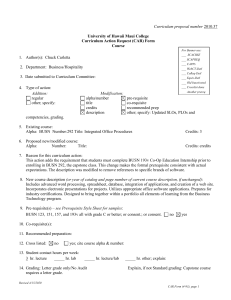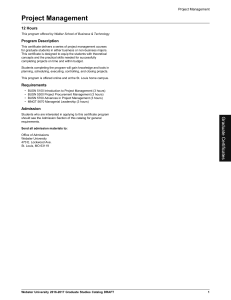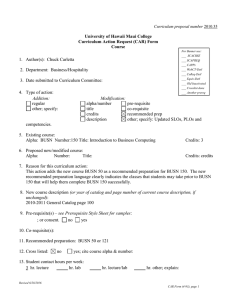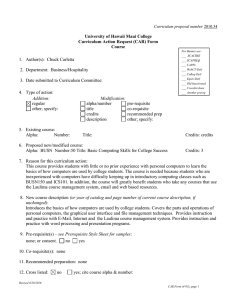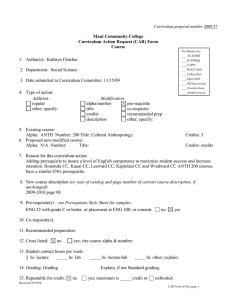F09 Modify,
advertisement
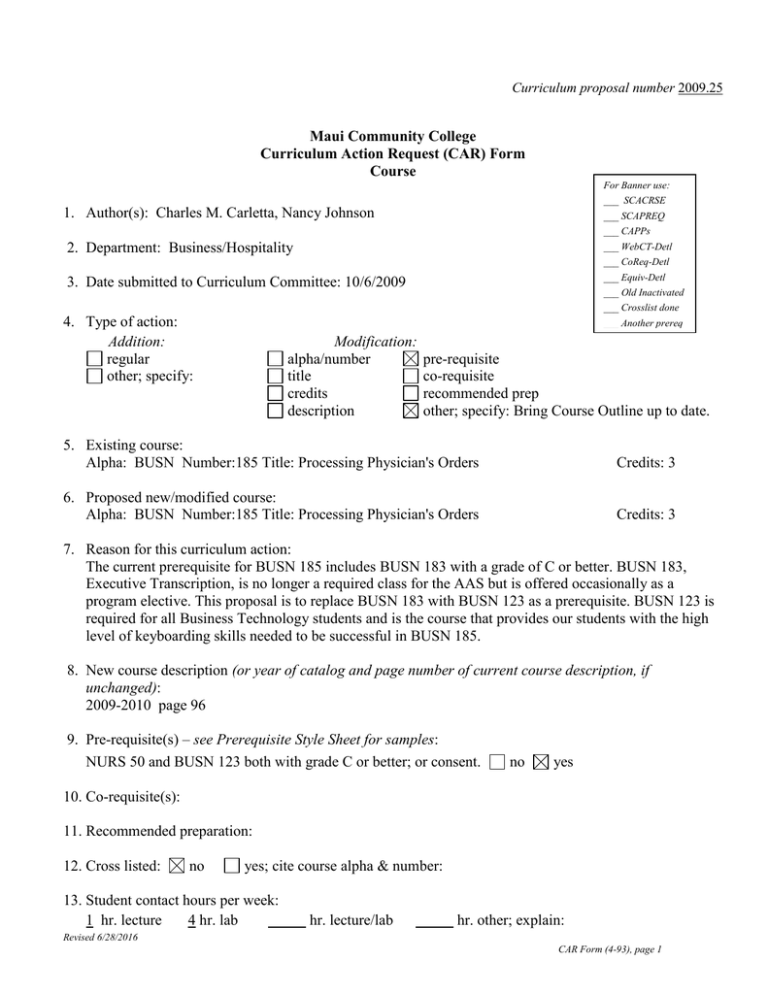
Curriculum proposal number 2009.25 Maui Community College Curriculum Action Request (CAR) Form Course For Banner use: ___ SCACRSE 1. Author(s): Charles M. Carletta, Nancy Johnson ___ SCAPREQ ___ CAPPs 2. Department: Business/Hospitality ___ WebCT-Detl ___ CoReq-Detl ___ Equiv-Detl 3. Date submitted to Curriculum Committee: 10/6/2009 ___ Old Inactivated ___ Crosslist done 4. Type of action: Addition: regular other; specify: ___ Another prereq Modification: alpha/number title credits description pre-requisite co-requisite recommended prep other; specify: Bring Course Outline up to date. 5. Existing course: Alpha: BUSN Number:185 Title: Processing Physician's Orders Credits: 3 6. Proposed new/modified course: Alpha: BUSN Number:185 Title: Processing Physician's Orders Credits: 3 7. Reason for this curriculum action: The current prerequisite for BUSN 185 includes BUSN 183 with a grade of C or better. BUSN 183, Executive Transcription, is no longer a required class for the AAS but is offered occasionally as a program elective. This proposal is to replace BUSN 183 with BUSN 123 as a prerequisite. BUSN 123 is required for all Business Technology students and is the course that provides our students with the high level of keyboarding skills needed to be successful in BUSN 185. 8. New course description (or year of catalog and page number of current course description, if unchanged): 2009-2010 page 96 9. Pre-requisite(s) – see Prerequisite Style Sheet for samples: NURS 50 and BUSN 123 both with grade C or better; or consent. no yes 10. Co-requisite(s): 11. Recommended preparation: 12. Cross listed: no yes; cite course alpha & number: 13. Student contact hours per week: 1 hr. lecture 4 hr. lab hr. lecture/lab hr. other; explain: Revised 6/28/2016 CAR Form (4-93), page 1 14. Grading: Standard (Letter, Cr/NCr, Audit) Explain, if not Standard grading: 15. Repeatable for credit: no yes; maximum is credit or unlimited. (Most courses are not repeatable for additional credit; exceptions are courses such as internships and co-op courses.) 16. Special fees required: no yes; explain: 17. Proposed term of first offering: semester of year. 18. List catalog used and then degrees, certificates, prerequisites, and catalog sections and their page numbers affected by this proposal: 2009-2010, page 96 19. Maximum enrollment: 24 Rationale, if less than 35: Requires computer classroom. 20. Special resources (personnel, supplies, etc.) required: no yes; explain: 21. Course is restricted to particular room type: no yes; explain: Requires computer classroom. 22. Special scheduling considerations: no yes; explain: 23. Method(s) of delivery appropriate for this course: (check all that apply) Traditional HITS/Interactive TV Cable TV Online Other, explain: Hybrid 24. Mark all college-wide general education SLOs this course supports. Std 1 - Written Communications Std 2 – Quantitative Reasoning Std 3 - Information Retrieval and Technology Std 4 - Oral Communication Std 5 - Critical Reasoning Std 6 – Creativity Other General Education SLOs, such as Ethics, Scientific Inquiry, or Service Learning. Explain: 25. List all program SLOs this course supports? (Explain, if necessary) Program SLO 1: Program SLO 2: Program SLO 3: X Program SLO 4: Program SLO 5: X 26. Explain: Explain: Explain: Explain: Explain: Course fulfills the following general education elective (GE) for CTE (Career Technical Education) AS/AAS degrees (GE): English (EN)/Communication (CM) Quantitative Reasoning (QR) Humanities (HU) Natural Science (NS) Social Science (SS) Other: Course is a requirement for the Business Technology program(s) AS/AAS degree or certificate Revised 6/28/2016 CAR Form (4-93), page 2 Course is a program elective for the program(s) AS/AAS degree or certificate 27. Course fulfills the following general education elective (GE) for the ABIT BAS degree: English (EN)/Communication (CM) Quantitative Reasoning (QR) Humanities (HU) Natural Science (NS) Social Science (SS) Other: Course is a requirement for the ABIT BAS degree Course is a program elective for the ABIT BAS degree 28. Course fulfills a requirement for a proposed BAS degree: Pre- requisite course Core Capstone Course (CC) Other: Course is a program elective for a proposed BAS degree Course fulfills the following general education elective (GE) for the proposed BAS English (EN)/Communication (CM) Quantitative Reasoning (QR) Humanities (HU) Natural Science (NS) Social Science (SS) Other: Course is applicable to the following additional BAS degrees: 29. degree: Course satisfies the following category for the AA degree*: Category I: Foundations/Skills: Foundations I Written Communication in English (FW) Global and Multicultural Perspectives (FG) Group A (before 1500 CE) Group B (since 1500 CE) Group C (pre-history to present) Symbolic Reasoning (FS) Category I: Foundations/Skills: Foundations II Numeracy (FN) Oral Communication in English (FO) Computer/Information Processing and Retrieval (FI) Category II: Breadth of Understanding and Experience Human Understanding The Individual (IN) The Community (CO) The Community – Global Perspective (CG) Human Expression (HE) Environmental Awareness (EA) Environmental Awareness – Global Perspective (EG) Asia/Pacific Perspective (AP) Category III Focus/Specialization/Area of Interest Interest Area Discipline/Alpha: Elective (LE) Other Graduation Requirements Writing Intensive (is appropriate for WI) Environmental Awareness Lab/course with lab (EL) Hawaii Emphasis (HI) Revised 6/28/2016 CAR Form (4-93), page 3 * Submit the appropriate form(s) to have the course placed in the requested category (ies). Submit a course outline, CAR, and appropriate forms to both the Curriculum Committee and the Foundations Board, if the course satisfies Category I: Foundations/Skills: Foundations I or II. 30. Course increases decreases makes no change to number of credits required for program(s) affected by this action. Explain, if necessary: 31. Course is taught at another UH campus (see Sections 5 and 6 above): no Explain why this course is proposed for MCC: yes Specify college(s), course, alpha, and number where same or similar course is taught: 32. Course is: Not appropriate for articulation. Appropriate* for articulation as a general education course at: UHCC UH Manoa UH Hilo UHWO Previously articulated* as a general education course at: UHCC UH Manoa UH Hilo UHWO *Note: Submit Course Articulation Form if course is already articulated, or is appropriate for articulation, as a general education (100-, 200-level) course. Standardized and/or appropriate for articulation by PCC or other UH system agreement at: UHCC UH Manoa UH Hilo UHWO Explain: Appropriate for articulation or has previously been articulated to a specific department or institution: UHCC UH Manoa UH Hilo UHWO Outside UH system Explain: 33. Additional Information (add additional pages if needed): Revised 6/28/2016 CAR Form (4-93), page 4 Maui Community College Curriculum Action Request (CAR) Signature Page __________________________________________________________________________ Proposed by: Author or Program Coordinator Date __________________________________________________________________________ Checked by: Academic Subject Area Representative to Curriculum Committee Date __________________________________________________________________________ Requested by Department: Department Chair Date __________________________________________________________________________ Recommended by: Curriculum Chair Date __________________________________________________________________________ Approved by Academic Senate: Academic Senate Chair Date __________________________________________________________________________ Endorsed by: Chief Academic Officer Date __________________________________________________________________________ Approved by: Chancellor Date Revised 6/28/2016 CAR Form (4-93), page 5 Maui Community College Course Outline 1. Alpha BUSN Number 185 Course Title Processing Physician's Orders Credits 3 Department Business/Hospitality Date of Outline 9/18/2009 2. Course Description: Author Charles M. Carletta, Nancy Johnson Effective Date 5-year Review Date Introduces skills for transcribing physician orders. Includes transcribing medication, intravenous, admission, pre-operative, post-operative, and referral orders. Includes computer transcriptions. (Formerly BUS185.) Cross-list Contact Hours/Type Three (3) hours One (1) hour Lecture/ Four (4) hour Lab 3. Pre-requisites NURS 50 with at least a C, and BUSN 123 with at least a C; or consent. Pre-requisite may be waived by consent yes no Co-requisites Recommended Preparation 4. Function/Designation AS Program AA Category Category Additional Category List Additional Programs and Category: AAS Program PR - Program Requirement BAS Program Category Developmental/Remedial List Additional Programs and Category: List Additional Programs and Category: Other/Additional: Explain: See Curriculum Action Request (CAR) form for the college-wide general education student learning outcomes (SLOs) and/or the program learning outcomes (PLOs) this course supports. This course outline is standardized and/or the result of a community college or system-wide agreement. Revised 6/28/2016 CAR Form (4-93), page 6 Responsible committee: 5. Student Learning Outcomes (SLOs): List one to four inclusive SLOs. For assessment, link these to #7 Recommended Course Content, and #9 Recommended Course Requirements & Evaluation. Use roman numerals (I., II., III.) to designate SLOs On successful completion of this course, students will be able to: I. Read, transcribe and process handwritten and computerized physicians' orders for typical services required for patient care. II. III. IV. 6. Competencies/Concepts/Issues/Skills For assessment, link these to #7 Recommended Course Content, and #9 Recommended Course Requirements & Evaluation. Use lower case letters (a., b.…zz. )to designate competencies/skills/issues On successful completion of this course, students will be able to: a. Transcribe complete medication orders with accuracy, including standing medications, continuing medications, PRN, STAT, and short-term medications. b. Transcribe medication renewals, changes, and discontinuation of medication orders. c. Transcribe continuous intravenous, intravenous medication and variable dose medication orders. d. Transcribe routing admission, STAT, laboratory, imaging, x-ray, urological, gastrointestinal, and discharge orders. e. Transcribe pre-operative, post-operative, computerized radiology and other computerized orders. f. Read and transcribe handwritten, total parenteral nutrition, gynecology, orthopedic, diabetic, neurological, respiratory, physical medicine, and occupational therapy orders. g. Describe computer functions and utilize the computer to retrieve medical and patient data. 7. Suggested Course Content and Approximate Time Spent on Each Topic Linked to #5. Student Learning Outcomes and # 6 Competencies/Skills/Issues 1-2 Weeks: Health Unit Coordinating History; The Nursing Department; Organization & Structure, Relationships; The Hospital Environment; Review of Communication Devices; Telephone Etiquette & Communication Skills; Review of Medical-Legal Considerations; Medical Terminology. (I,a,b,c,d,e,f,g) 1-2 Weeks: The Patient Record; Kardex; Introduction to Transcription of Physicians Orders; General Principles. (I,a,b,c,d,e,f,g) 1-2 Weeks: Transcription of Physicians Orders; Medication Orders - characteristics; Transcription of standing, continuing, PRN, STAT and short-term orders. (I, a) 1-2 Weeks: Transcription of medication renewals, changes, and discontinuation of medication orders; IV Medication Orders. (I,b,c) Revised 6/28/2016 CAR Form (4-93), page 7 1-2 Weeks: Transcription of Laboratory Orders; Transcription of Imaging Orders including Radiology; Diagnostic Radiology & X-Ray. (I,d,e) 1-2 Weeks: Transcription of Treatment Orders including: Nursing Treatments, Physical Therapy, Occupational Therapy, and Respiratory Therapy. (I,f) 1-2 Weeks: Transcription of Pre-Operative, Peri-Operative and Post-Operative Orders. (I,e) 1-2 Weeks: Transcription of Social Services; Specialty Services Orders including TPN, GYN, Orthopedic, Diabetic, Cardiac, Neuro and Pediatric Orders. (I,f) 1-2 Weeks: Transcription of Intravenous Orders including Continuous, Non-Continuous & Blood Products. (I,c) 1-2 Weeks: Practicum at Kaiser Hospital; Practicum at Maui Memorial Hospital. (I,a,b,c,d,e,f,g) 1-2 Weeks: Out Patient Billing and Records. (I,a,b,c,d,e,f,g) 8. Text and Materials, Reference Materials, and Auxiliary Materials Appropriate text(s) and materials will be chosen at the time the course is offered from those currently available in the field. Examples include: La Fleur-Brooks, Myrna and Starr, Windfred K. "Health Unit Coordinating," 3rd Ed. Philadelphia, PA, W.B. Saunders, 1993. La Fleur-Brooks, Myrna and Schneider, Patricia, "Skills Practice Manual for Health Unit Coordinating," Philadelphia, PA, W.B. Saunders, 1993. Appropriate reference materials will be chosen at the time the course is offered from those currently available in the field. Examples include: Appropriate auxiliary materials will be chosen at the time the course is offered from those currently available in the field. Examples include: Articles and/or handouts prepared by the instructor. Magazine or Newspaper Articles Accompanying computer patient and medical records database if available. Appropriate films, videos or internet sites. Television programs. Guest Speakers. Other Instructional Aids. 9. Suggested Course Requirements and Evaluation Linked to #5. Student Learning Outcomes (SLOs) and #6 Competencies/Skills/Issues Revised 6/28/2016 CAR Form (4-93), page 8 Specific course requirements are at the discretion of the instructor at the time the course is being offered. Suggested requirements might include, but are not limited to: Examinations (written and/or oral) In-class exercises Homework Medical records processing Quizzes Projects/research Attendance and/or class participation 30-60% 0-10% 0-30% 0-20% 0-30% 0-40% 0-30% (I,a,b,c,d,e,f,g) (I,a,b,c,d,e,f,g) (I,a,b,c,d,e,f,g) (I,a,b,c,d,e,f,g) (I,a,b,c,d,e,f,g) (I,a,b,c,d,e,f,g) (I,a,b,c,d,e,f,g) 10. Methods of Instruction Instructional methods will vary considerably by instructor. Specific methods are at the discretion of the instructor teaching the course and might include, but are not limited to: Lecture, problem solving, and class exercises or readings; class ddiscussions; guest lectures; audio-visual or Internet presentations; student class presentations; group or individual projects; other contemporary learning techniques (e.g., Service-Learning, Co-op, School-to-Work, self-paced, etc.) 11. Assessment of Intended Student Learning Outcomes Standards Grid attached 12. Additional Information: Assessment of Intended Student Learning Outcomes Standards – CCOWIQs with Ratings for BUSN 185 Key: 3 = Major Emphasis: The student is actively involved (uses, reinforces, applies, and evaluated) in the student learning outcomes. The learner outcome is the focus of the class. 2 = Moderate Emphasis: The student uses, reinforces, applies and is evaluated by this learner outcome, but it is not the focus of the class 1 = Minor Emphasis: The student is provided an opportunity to use, reinforce, and apply this learner outcome, but does not get evaluated on this learner outcome 0 = No Emphasis: The student does not address this learner outcome Standard 1: Written Communication Program graduates are able to write effectively to convey ideas that meet the needs of specific audiences and purposes. 1. Use writing to discover and articulate ideas 1.2 Identify and analyze the audience and purpose for any intended communication 1.3 Choose language, style and organization appropriate to particular purposes and audiences 1.4 Gather information and document sources appropriately 1.5 Express a main idea as a thesis, hypothesis, and other appropriate content 1.6 Develop a main idea clearly and concisely with appropriate content 1.7 Demonstrate mastery of the conventions of writing, including grammar, spelling, and mechanics 1.8 Demonstrate proficiency in revision and editing 1.9 Develop a personal voice in written communication Standard 2: Quantitative Reasoning BUSN 185 1 1 1 1 2 1 1 1 1 1 Revised 6/28/2016 CAR Form (4-93), page 9 Program graduates are able to synthesize and articulate information using appropriate mathematical methods to solve problems and logically address real-life situations. 2.1 Apply numeric, graphic and symbolic skills and other forms of quantitative reasoning, accurately and appropriately 2.2 Demonstrate mastery of mathematical concepts, skills, and applications, using technology when appropriate 2.3 Communicate clearly and concisely the methods and results of quantitative problem solving 2.4 Formulate and test hypotheses using numerical experimentation 2.5 Define quantitative issues and problems, gather relevant information, analyze that information, and present results 2.6 Assess the validity of statistical conclusions Standard 3: Information Retrieval and Technology (Information Literacy) Program graduates are able to access, evaluate, and utilize information effectively, ethically and responsibly. 3.1 Use print and electronic information technology ethically and responsibly 3.2 Demonstrate knowledge of basic vocabulary, concepts, and operations of information technology and retrieval 3.3 Recognize, identify, and define an information need 3.4 Access and retrieve information through print and electronic media, evaluating the accuracy and authenticity of that information 3.5 Create, manage, organize, and communicate information through electronic media 3.6 Recognize changing technologies and make informed choices about their appropriateness and use. Standard 4: Oral Communication Program graduates are able to practice ethical and responsible oral communications appropriate to a variety of audiences and purposes. 4.1 Identify and analyze the audience and purpose of any intended communication. 4.2 Gather, evaluate, select, and organize information for the communication. 4.3 Use language, techniques, and strategies appropriate to the audience and occasion. 4.4 Speak clearly and confidently, using the voice, volume, tone, and articulation appropriate to the audience and occasion 4.5 Summarize, analyze, and evaluate oral communications and ask coherent questions as needed. 4.6 Use competent oral expression to initiate and sustain discussion. Standard 5: Critical Thinking Program graduates are able to apply critical reasoning skills to effectively address the challenges and solve problems. 5.1 Identify and state problems, issues, arguments, and questions contained in a body of information. 5.2 Identify and analyze assumptions and underlying points of view relating to an issue or problem. 5.3 Formulate research questions that require descriptive and explanatory analyses. 5.4 Recognize and understand multiple modes of inquiry, including investigative methods based on observation and analysis. 5.5 Evaluate a problem, distinguishing between relevant and irrelevant facts, opinions, assumptions, issues, values, and biases through the use of appropriate evidence. 5.6 Apply problem-solving techniques and skills, including the rules of logic and logical sequence. 5.7 Synthesize inform from various sources, drawing appropriate conclusions. 5.8 Communicate clearly and concisely the methods and results of logical reasoning. 5.9 Reflect upon and evaluate their thought processes, value system, and world views in comparison to those of others. Standard 6: Creativity A student who graduates from MCC with a degree can express originality through a variety of forms. 6.1 Generates responses to problems and challenges through intuition and non-linear thinking. 6.2 Explores diverse approaches to solving a problem or addressing a challenge. 6.3 Sustains engagement in activities without a preconceived purpose. 6.4 Demonstrates the ability to trust and follow one’s instincts in the absence of external direction. 6.5 Applies creative principles to discover and express new ideas. 6.6 Builds upon or adapts the ideas of others to create novel expressions or new solutions. 0 1 0 0 0 0 0 2 1 2 2 2 2 1 1 1 1 1 1 1 0 1 1 0 0 0 1 1 1 1 0 1 1 0 0 1 1 1 Revised 6/28/2016 CAR Form (4-93), page 10

